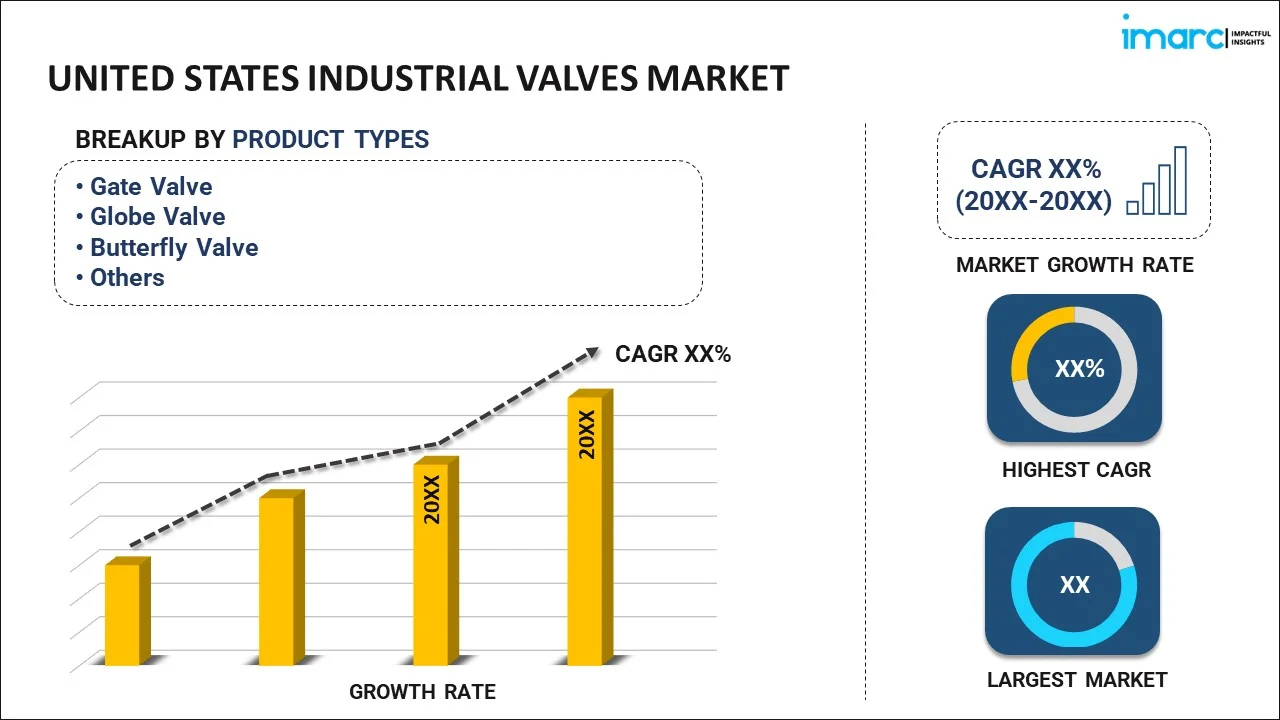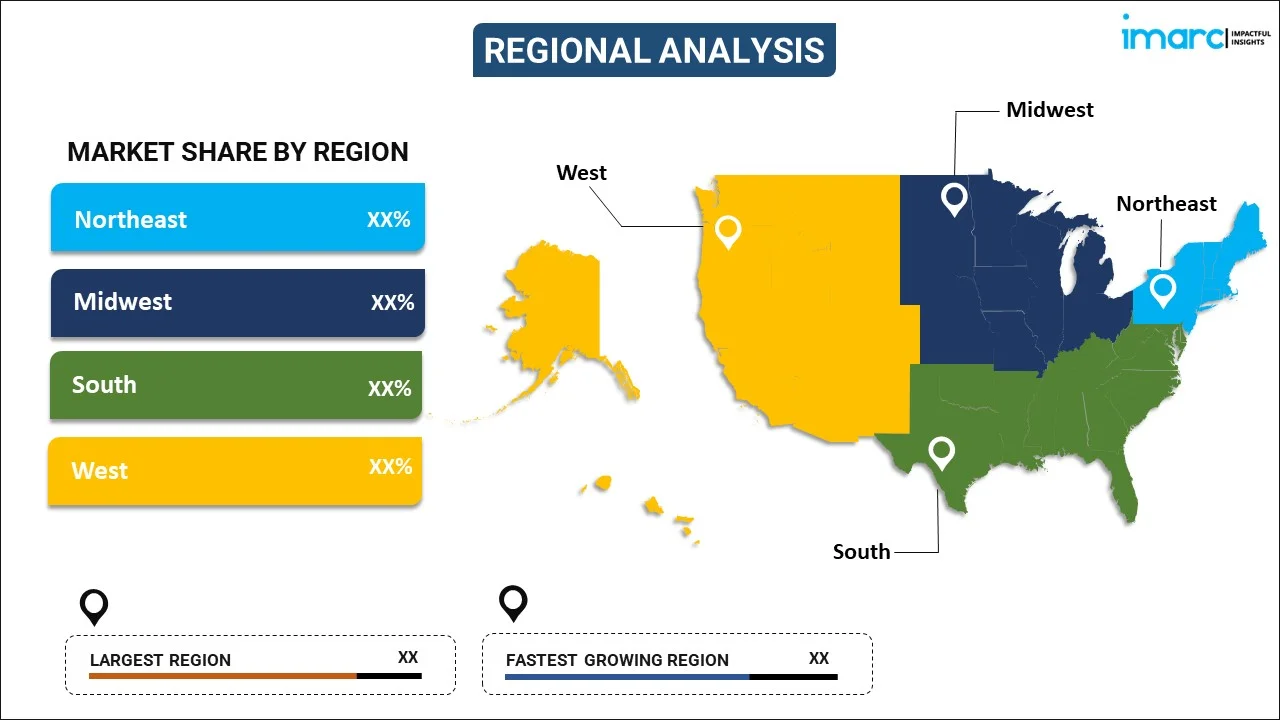
United States Industrial Valves Market Report by Product Type (Gate Valve, Globe Valve, Butterfly Valve, Ball Valve, Check Valve, Plug Valve, and Others), Functionality (On-Off/Isolation Valves, Control Valves), Material (Steel, Cast Iron, Alloy Based, and Others), Size (Up to 1”, 1”-6”, 7”-25”, 26”-50”, 51” and Above), End Use Industry (Oil and Gas, Power, Pharmaceutical, Water and Wastewater Treatment, Chemical, Food and Beverage, and Others), and Region 2025-2033
Market Overview:
United States industrial valves market size reached USD 11.4 Million in 2024. Looking forward, IMARC Group expects the market to reach USD 15.8 Million by 2033, exhibiting a growth rate (CAGR) of 3.63% during 2025-2033. The ongoing process of industrialization, which leads to increased demand for industrial valves across various sectors such as oil and gas, chemicals, power generation, and water and wastewater treatment, is driving the market.
|
Report Attribute
|
Key Statistics
|
|---|---|
|
Base Year
|
2024
|
|
Forecast Years
|
2025-2033
|
|
Historical Years
|
2019-2024
|
|
Market Size in 2024
|
USD 11.4 Million |
|
Market Forecast in 2033
|
USD 15.8 Million |
| Market Growth Rate 2025-2033 | 3.63% |
Industrial valves are essential components in various industrial processes, serving to control the flow of fluids or gases within pipelines. These valves play a crucial role in regulating, isolating, and directing the movement of substances in diverse applications, such as manufacturing, energy production, and water treatment. Industrial valves come in a variety of types, including gate valves, globe valves, ball valves, and butterfly valves, each designed for specific functions and conditions. They are pivotal in maintaining process efficiency, safety, and reliability by managing fluid flow and pressure. The selection of the appropriate valve depends on factors like the nature of the fluid, operating conditions, and the intended purpose. With advancements in technology, modern industrial valves often incorporate innovative materials and designs to enhance performance and durability, contributing to the seamless operation of industrial processes.
United States Industrial Valves Market Trends:
The industrial valves market in the United States is poised for robust growth, propelled by several key drivers that collectively shape its trajectory. Firstly, the increasing demand for efficient fluid control mechanisms across diverse industries acts as a significant catalyst. As manufacturing processes become more sophisticated and specialized, the need for precise and reliable valve systems intensifies, driving the market forward. Furthermore, the ongoing regional emphasis on sustainability and environmental consciousness plays a pivotal role in steering the industrial valves market. Stricter regulations regarding resource conservation and emissions control mandate the integration of advanced valve technologies to enhance operational efficiency and minimize environmental impact. Consequently, the market experiences an upsurge as industries strive to adhere to stringent environmental standards. Moreover, technological advancements in valve design and materials contribute substantially to market expansion. The integration of smart technologies, such as sensors and automation, enhances the performance and monitoring capabilities of industrial valves, catering to the growing demand for efficiency and precision in industrial processes. This synergy of technological innovation and industrial demands creates a favorable landscape for sustained market growth. In essence, the regional industrial valves market is not merely responding to market forces but actively driving its evolution through a nexus of demand dynamics, environmental imperatives, and technological progress.
United States Industrial Valves Market Segmentation:
IMARC Group provides an analysis of the key trends in each segment of the market, along with forecasts at the country level for 2025-2033. Our report has categorized the market based on product type, functionality, material, size, and end use industry.
Product Type Insights:

- Gate Valve
- Globe Valve
- Butterfly Valve
- Ball Valve
- Check Valve
- Plug Valve
- Others
The report has provided a detailed breakup and analysis of the market based on the product type. This includes gate valve, globe valve, butterfly valve, ball valve, check valve, plug valve, and others.
Functionality Insights:
- On-Off/Isolation Valves
- Control Valves
A detailed breakup and analysis of the market based on the functionality have also been provided in the report. This includes on-off/isolation valves and control valves.
Material Insights:
- Steel
- Cast Iron
- Alloy Based
- Others
The report has provided a detailed breakup and analysis of the market based on the material. This includes steel, cast iron, alloy based, and others.
Size Insights:
- Up to 1”
- 1”-6”
- 7”-25”
- 26”-50”
- 51” and Above
A detailed breakup and analysis of the market based on the size have also been provided in the report. This includes up to 1”, 1”-6”, 7”-25”, 26”-50”, and 51” and above.
End Use Industry Insights:
- Oil and Gas
- Power
- Pharmaceutical
- Water and Wastewater Treatment
- Chemical
- Food and Beverage
- Others
The report has provided a detailed breakup and analysis of the market based on the end use industry. This includes oil and gas, power, pharmaceutical, water and wastewater treatment, chemical, food and beverage, and others.
Regional Insights:

- Northeast
- Midwest
- South
- West
The report has also provided a comprehensive analysis of all the major regional markets, which include Northeast, Midwest, South, and West.
Competitive Landscape:
The market research report has also provided a comprehensive analysis of the competitive landscape. Competitive analysis such as market structure, key player positioning, top winning strategies, competitive dashboard, and company evaluation quadrant has been covered in the report. Also, detailed profiles of all major companies have been provided.
United States Industrial Valves Market Report Coverage:
| Report Features | Details |
|---|---|
| Base Year of the Analysis | 2024 |
| Historical Period | 2019-2024 |
| Forecast Period | 2025-2033 |
| Units | Million USD |
| Scope of the Report | Exploration of Historical and Forecast Trends, Industry Catalysts and Challenges, Segment-Wise Historical and Predictive Market Assessment:
|
| Product Types Covered | Gate Valve, Globe Valve, Butterfly Valve, Ball Valve, Check Valve, Plug Valve, Others |
| Functionalities Covered | On-Off/Isolation Valves, Control Valves |
| Materials Covered | Steel, Cast Iron, Alloy Based, Others |
| Sizes Covered | Up to 1”, 1”-6”, 7”-25”, 26”-50”, 51” and Above |
| End Use Industries Covered | Oil and Gas, Power, Pharmaceutical, Water and Wastewater Treatment, Chemical, Food and Beverage, Others |
| Regions Covered | Northeast, Midwest, South, West |
| Customization Scope | 10% Free Customization |
| Post-Sale Analyst Support | 10-12 Weeks |
| Delivery Format | PDF and Excel through Email (We can also provide the editable version of the report in PPT/Word format on special request) |
Key Questions Answered in This Report:
- How has the United States industrial valves market performed so far and how will it perform in the coming years?
- What has been the impact of COVID-19 on the United States industrial valves market?
- What is the breakup of the United States industrial valves market on the basis of product type?
- What is the breakup of the United States industrial valves market on the basis of functionality?
- What is the breakup of the United States industrial valves market on the basis of material?
- What is the breakup of the United States industrial valves market on the basis of size?
- What is the breakup of the United States industrial valves market on the basis of end use industry?
- What are the various stages in the value chain of the United States industrial valves market?
- What are the key driving factors and challenges in the United States industrial valves?
- What is the structure of the United States industrial valves market and who are the key players?
- What is the degree of competition in the United States industrial valves market?
Key Benefits for Stakeholders:
- IMARC’s industry report offers a comprehensive quantitative analysis of various market segments, historical and current market trends, market forecasts, and dynamics of the United States industrial valves market from 2019-2033.
- The research report provides the latest information on the market drivers, challenges, and opportunities in the United States industrial valves market.
- Porter's five forces analysis assist stakeholders in assessing the impact of new entrants, competitive rivalry, supplier power, buyer power, and the threat of substitution. It helps stakeholders to analyze the level of competition within the United States industrial valves industry and its attractiveness.
- Competitive landscape allows stakeholders to understand their competitive environment and provides an insight into the current positions of key players in the market.
Need more help?
- Speak to our experienced analysts for insights on the current market scenarios.
- Include additional segments and countries to customize the report as per your requirement.
- Gain an unparalleled competitive advantage in your domain by understanding how to utilize the report and positively impacting your operations and revenue.
- For further assistance, please connect with our analysts.
 Inquire Before Buying
Inquire Before Buying
 Speak to an Analyst
Speak to an Analyst
 Request Brochure
Request Brochure
 Request Customization
Request Customization




.webp)




.webp)












